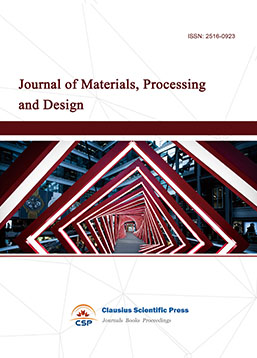Determination of trace bismuth in soil and sediment by ultrasonic water bath digestion-Atomic Fluorescence Spectrometry
DOI: 10.23977/analc.2022.010101 | Downloads: 21 | Views: 1569
Author(s)
ZHOU Zi-Kai 1, LI Luan 1, ZHANG Chao 2
Affiliation(s)
1 School of Resources Environmental & Chemical Engineering, Nanchang University, Nanchang city, 330031, China
2 School of Materials Science and Engineering,Nanchang University,Nanchang city, 330031
Corresponding Author
ZHOU Zi-KaiABSTRACT
The Chinese national environmental standard detection method HJ 680-2013 was improved. The sample was pretreated and digested by acid mixtures and ultrasonic water bath digestion method. The trace bismuth in soil and sediment were determined by atomic fluorescence spectrometry. GBW07430, GBW07446 and GBW07452 were selected as the national first-class standard materials for soil composition analysis. The effects of 12kinds of acid mixtures digestion systems on the determination results of trace bismuth in soil and sediment were discussed, and the best experimental conditions were selected. The hydrochloric acid, nitric acid, sulfuric acid and hydrofluoric acid (volume ratio: 0.5:1.5:0.5:0.5) was used as the digestion solution in the acid mixtures system, and the samples were digested by ultrasonic water bath method. The digestion time was 0.5 h.That trace bismuth mass concentration were in the range of 0.10 to 10.0 μg/L and that had a good linear relationship, the linear correlation coefficient was more than 0.9998, the limit of detection (LOD) was 0.005 mg/kg, the limit of quantitation (LOQ) was 0.015 mg/kg, the relative standard deviations (RSD) were 0.39 to 6.65%, and the recoveries were 103 to 112%. The method has been verified by the national first-class standard material for soil composition analysis and the types of agricultural, construction soil and pipeline sludge sediment samples collected from Taizhou environment. It is proved that the method can effectively digest different types of samples, meet the current environmental analysis of soil and sediment detection work, and effectively improve the accurate and rapid determination work, the requirement of high-throughput sample determination of trace bismuth was solved.
KEYWORDS
Bismuth, Digestion methods, Soil, Sediment, Environmental monitoring, Atomic fluorescence spectrometryCITE THIS PAPER
ZHOU Zi-Kai, LI Luan, ZHANG Chao, Determination of trace bismuth in soil and sediment by ultrasonic water bath digestion-Atomic Fluorescence Spectrometry . Analytical Chemistry: A Journal (2022) Vol. 1: 1-9. DOI: http://dx.doi.org/10.23977/analc.2022.010101.
REFERENCES
[1] Guo Zu-tao. Modern chemical research,2017 (7): 9–11.
[2] GB 15618–2018. Soil environmental quality risk control standard for soil contamination of agricultural land (Trial). Beijing: Environmental Science Press of China
[3] GB 36600–2018. Soil environmental quality risk control standard for soil contamination of development land (Trial). Beijing: Environmental Science Press of China.
[4] DB 32/T 4032-2021. Soil and sediment-Determination of lithium, niobium, tin and bismuth-Inductively coupled plasma mass spectromet. Beijing: Environmental Science Press of China.
[5] HJ 608-2013. Soil and Sediment Determination of Mercury, Arsenic, Selenium, Bismuth, Antimony Microwave Dissolution/Atomic Fluorescence Spectrometry. Beijing: Environmental Science Press of China.
[6] Lin Hai-lan, Zhu Ri-long, Yu Lei, et al. Spectroscopy and Spectral Anlysis, 2020, 40(5): 1528-1533.
[7] GB 17378.3-2007. The specification for marine monitoring-Part 3: Sample collection, storage and transportation. Beijing: Environmental Science Press of China.
[8] HJ/T 166-2004. Technical specification for soil environmental monitoring. Beijing: Environmental Science Press of China.
[9] NY/T 395-2012. Technical rules for monitroing of environmental quality of farmland soil. Beijing: Environmental Science Press of China.
[10] HJ 613-2011. Soil-determination of dry matter and water content-gravimetric method.
[11] GB 17378.5-2007. The specification for marine monitoring-Part 5:sediment analysis
[12] Zhou Zi-kai, Bao Yi-fan, Ye Chang-lin, Chemical Analysis and Meterage, 2020, 29(6):61-66
[13] Lin Hai-lan, Li Zhi-huang, Zhu Ri-long, et al. Spectroscopy and Spectral Anlysis, 2016, 36(4): 1217-1220.
[14] Xin Wen-cai, Zhang Bo, Xia Ning, et al. Physical Testing and Chemical Analysis Part B: Chemical Analysis, 2010, 46(2):143-145.
| Downloads: | 511 |
|---|---|
| Visits: | 19028 |
Sponsors, Associates, and Links
-
Forging and Forming

-
Composites and Nano Engineering

-
Journal of Materials, Processing and Design

-
Metallic foams

-
Smart Structures, Materials and Systems

-
Chemistry and Physics of Polymers

-
Modern Physical Chemistry Research

-
Inorganic Chemistry: A Journal

-
Organic Chemistry: A Journal

-
Progress in Materials Chemistry and Physics

-
Transactions on Industrial Catalysis

-
Fuels and Combustion

-
Casting, Welding and Solidification

-
Journal of Membrane Technology

-
Journal of Heat Treatment and Surface Engineering

-
Trends in Biochemical Engineering

-
Ceramic and Glass Technology

-
Transactions on Metals and Alloys

-
High Performance Structures and Materials

-
Rheology Letters

-
Plasticity Frontiers

-
Corrosion and Wear of Materials

-
Fluids, Heat and Mass Transfer

-
International Journal of Geochemistry

-
Diamond and Carbon Materials

-
Advances in Magnetism and Magnetic Materials

-
Advances in Fuel Cell

-
Journal of Biomaterials and Biomechanics


 Download as PDF
Download as PDF